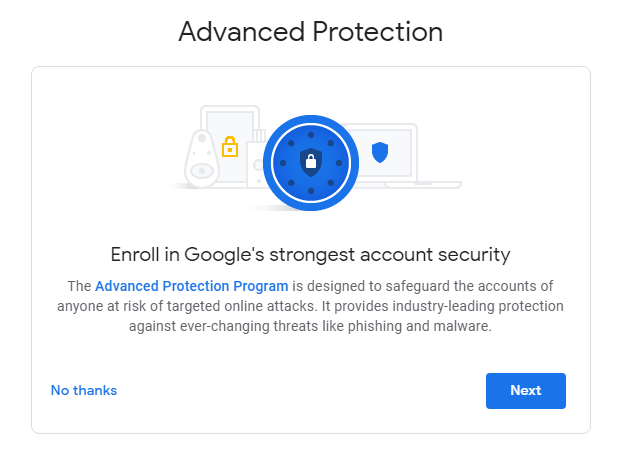
People like politicians, journalists, activists, business leaders and some others are the most valuable to hackers because of the information they may hold.
This is why Google has what it calls 'Advanced Protection Program', which is a security offering that helps safeguard Google Accounts of those at risk for targeted attacks.
If compared to normal Google accounts, accounts enrolled in this program benefits from an increased level of protection for these accounts by limiting access to data, blocking fraudulent account access, supporting the use of physical security keys, and more.
And here, Google said that its "strongest account security" has added new malware protections to the program, as well.
For starters, those who are enrolled in the Advanced Protection Program will have Google Play Protect automatically enabled.
This protection replaces Google's previous "Verify Apps" feature, and makes security more transparent and more prominent to the users. This is the same built-in malware protection Google uses for Android to scan and verify 100 billion apps per day.
Google noted that the system uses machine learning to automatically scan users’ device and apps to check for harmful behavior and potential security issues.
With the malware protection, users are also limited in their ability to install apps outside from the Play Store.
Because apps that aren't hosted at Google aren't scanned for malware, they can present greater risks. For this reason, Google is preventing the downloads of non-Play Store apps on any Android devices enrolled in the Advanced Protection Program.
But there are exceptions.
For example, users can still install non-Play Store apps through third-party app stores that may have been shipped on their device from the device manufacturer. Other non-Play Store apps can also be installed through the developer tool Android Debug Bridge.
This added protections are rolling out gradually to all Google accounts enrolled in Advanced Program on Android devices.

Google first launched its Advanced Protection Program in fall 2017, as an opt-in option for those who believe they’re at increased risk of online attacks.
The program focuses on defending against phishing, locking down malicious apps, and fending off hackers.
The trade-off is reduced conveniences, because Google forces additional steps to be taken during authentication, as well as more limitations on what users can do.
It was initially rolled out in the wake of a series of sophisticated hacking campaigns that have targeted Gmail and focused on the accounts of influential people.
But then Google rolled it out to all Google users, as an opt-in option to whoever wishes it.
"There is an overlooked minority of our users that are at particularly high risk of targeted online attacks," said Google' security team on a blog post.
"For example, these might be campaign staffers preparing for an upcoming election, journalists who need to protect the confidentiality of their sources, or people in abusive relationships seeking safety."
And with Google adding malware protection to its Advanced Protection Program, users who enrolled to the program should benefit greatly.
What should be noted is that, with the update, this malware security feature is enabled by default for all users enrolled in Advanced Protection Program members, with Google in giving no option to turn it off.